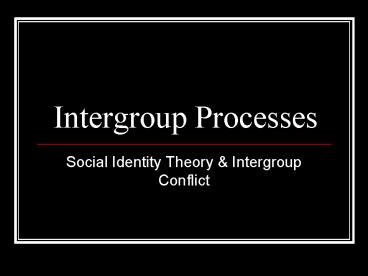Intergroup Processes - PowerPoint PPT Presentation
1 / 25
Title:
Intergroup Processes
Description:
How do we establish our identity in any given social situation? ... Ashmore, R.D., Jussim, L. & Wilder, D. (2001) Social Identity, Intergroup ... – PowerPoint PPT presentation
Number of Views:128
Avg rating:3.0/5.0
Title: Intergroup Processes
1
Intergroup Processes
- Social Identity Theory Intergroup Conflict
2
Social Identity Theory and Intergroup Conflict
- Social Identity Theory
- What is social identity?
- How are social identities formed?
- How do we select our social identities?
- Social identity and intergroup conflict
- How / why do social identities lead to conflict?
- How do they perpetuate conflict?
3
Who Are You?
- How do you communicate your identity to others?
- How do we establish our identity in any given
social situation? - What are the implications of the identities that
we have?
4
Identity as a Continuum
Personal Identity
Social Identity
(Intergroup behaviour)
(Interpersonal behaviour)
Identification by oneself
Identification by others
5
Social Identity Theory (SIT)
- Developed by Tajfel (1972)
- Focuses on the groups within the individual
- Social categories become actual human groups
- Awareness of group membership emotional
attachment to the group are the key in SIT
6
SIT continued
- 2 key components
- The belief that we belong to a group
- The importance of the group membership to us
- Levels of self
- Not one personal self but many selves
- The social context dictates which self we
identify with
7
SIT and Self-definition
- Self-definition comes from the social categories
to which we belong - Social categories both describe and prescribe our
attitudes - As a result of this, we engage in stereotypical
behaviours
8
In-Group Favouritism
- In-group favouritism is likely when
- 1. Membership of the group is important in how
we define ourselves - 2. There is opportunity for comparisons with
other groups - 3. The comparison with other groups results in
an ambiguous outcome
9
Self-Categorisation Theory
- Focuses on how individuals categorise themselves
- Accentuates the in-group similarities and
out-group differences - Can result in depersonalisation, stereotyping and
collective behaviour
10
Group Formation Identity Salience
- Why do we need to identify with groups?
- To gain social structure and security
- To enhance our sense of self-esteem
11
Identity Selection and Religion
- Religious belief and affiliation help us develop
a secure identity (Seul, 1999) - Religion
- Stabilises individual and group identity (Hans
Mol, 1976) - Maintains identity via compliance,
identification, and internalisation (Kelman,
1998)
12
Social Identity and Religion
13
Social Identity, Self-Esteem, Group Loyalty
Cohesion
Group identification results in social agreement
Social agreement enhances self-esteem
Enhanced self-esteem increases group loyalty
Increased loyalty encourages group cohesion
14
In-groups and Out-groups
- Individuals perceive others either as members of
the same social category (in- group members) or
as members of a different social category
(out-group members) - People are classified on the grounds of
similarities or differences from the self
15
In-Group Love, Out-Group Hate
16
The Importance of Group Loyalty
- Loyalty is increased if
- There is a threat
- If there is the opportunity for loyalty to
increase - National identifications, in particular, are
strengthened during times of threat.
17
(No Transcript)
18
Identity and Hostility
- Group identities
- Exacerbate intergroup competition
- Encourage movements for change amongst lower
power and status groups - Are implicated in a variety of conflicts
- State violence against internal minorities
(Staub, 1989) - Uprisings by ethnic groups against governments
(Gurr, 1993) - International conflicts (Keegan, 1993)
19
Social Identity and Intergroup Conflict
- Sumner (1906)
- 1. Human social groups are organised into
discrete in-groups and out-groups - 2. Individuals value their in-groups positively
- 3. In-group positivity is enhanced by social
comparisons with out-groups - 4. Relationships between in- and out-groups are
often characterised by antagonism and conflict.
20
SIT and the Troubles in Northern Ireland.
21
Identity Divisions in Northern Ireland
Catholic
Protestant
Irish
British
Unionist
Nationalist
United Ireland
N. Ire remain part of UK
22
Social Identity in Northern Ireland
- Presence of threat and conflict has resulted in
more salient social identifications - Little, if any, opportunity for identity change
in Northern Ireland - Roots of identity in religion make identities
impermeable
23
In Summary
- What is social identity?
- How do we select and maintain our identities?
- Group loyalty and self-esteem
- Application of SIT to a real-life conflict
24
Next Week
- Intergroup contact and conflict resolution
- What does social identity have to offer to our
understanding of intergroup co-operation?
25
Recommended Reading
- Ashmore, R.D., Jussim, L. Wilder, D. (2001)
Social Identity, Intergroup Conflict and Conflict
Reduction. Oxford, UK Oxford University Press - Brewer, M.B. Hewstone, M. (2004) Self and
Social Identity. Oxford, UK Blackwell Publishing - Hogg, M.A. Abrams, D. (1996) Social
Identifications. London, UK Routledge - Robinson, W.P. (1996) Social Groups and
Identities. UK Butterworth-Heinemann Publishers.































